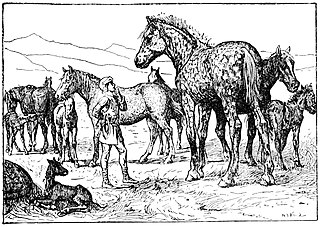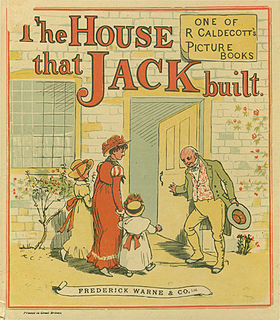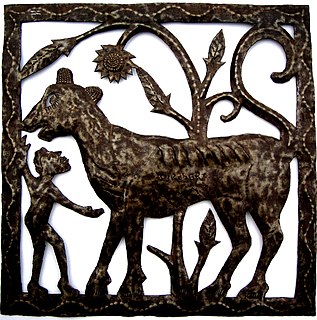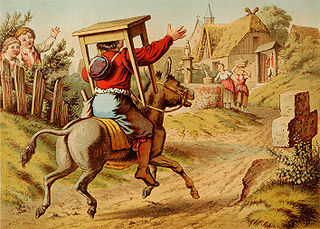Related Research Articles

"The Three Little Pigs" is a fable about three pigs who build three houses of different materials. A Big Bad Wolf blows down the first two pigs' houses, made of straw and sticks respectively, but is unable to destroy the third pig's house, made of bricks. Printed versions date back to the 1840s, but the story is thought to be much older. The earliest version takes place in Dartmoor with three pixies and a fox before its best known version appears in English Fairy Tales by Joseph Jacobs in 1890, with Jacobs crediting James Halliwell-Phillipps as the source.
The Aarne–Thompson–Uther Index is a catalogue of folktale types used in folklore studies. The ATU Index is the product of a series of revisions and expansions by an international group of scholars: Originally composed in German by Finnish folklorist Antti Aarne (1910), the index was translated into English, revised, and expanded by American folklorist Stith Thompson, and later further revised and expanded by German folklorist Hans-Jörg Uther (2004). The ATU Index, along with Thompson's Motif-Index of Folk-Literature (1932) is an essential tool for folklorists.
The Three Heads in the Well is a fairy tale collected by Joseph Jacobs in English Fairy Tales.

Dapplegrim (Grimsborken) is a Norwegian fairy tale collected by Peter Christen Asbjørnsen and Jørgen Moe in their Norske Folkeeventyr. Andrew Lang included it in The Red Fairy Book.
Rushen Coatie or Rashin-Coatie is a Scottish fairy tale collected by Joseph Jacobs in his More English Fairy Tales.
"Tattercoats" is an English fairy tale collected by Joseph Jacobs in his More English Fairy Tales.

"The Robber Bridegroom" is a German fairy tale collected by the Brothers Grimm, tale number 40. Joseph Jacobs included a variant, Mr Fox, in English Fairy Tales, but the original provenance is much older; Shakespeare alludes to the Mr. Fox variant in Much Ado About Nothing, Act 1, Scene 1:

"The Brave Little Tailor" or "The Valiant Little Tailor" or "The Gallant Tailor" is a German fairy tale collected by the Brothers Grimm. "The Brave Little Tailor" is a story of Aarne–Thompson Type 1640, with individual episodes classified in other story types.
Fair, Brown and Trembling is an Irish fairy tale collected by Jeremiah Curtin in Myths and Folk-lore of Ireland and Joseph Jacobs in his Celtic Fairy Tales.
Fairy Ointment or "The Fairy Nurse" is an English fairy tale collected by Joseph Jacobs in his English Fairy Tales. It has been told in many variants. Andrew Lang included one in The Lilac Fairy Book.

My Own Self, Me Aan Sel or Ainsel is a Northumbrian fairy tale collected by the folklorist Joseph Jacobs. A version of the tale appears in Scottish Folk Tales by Ruth Manning-Sanders. It is Aarne-Thompson type 1137, similar to the encounter between Odysseus and Polyphemus, and tells how a fairy is outsmarted by a human child through clever wordplay.
The Old Witch is an English fairy tale collected by Joseph Jacobs in his 1894 book, More English Fairy Tales. It is also included within A Book of Witches by Ruth Manning-Sanders and A Book of British Fairy Tales by Alan Garner.
"The Three Languages" is a German fairy tale collected by the Brothers Grimm, tale number 33. It is Aarne-Thompson type 671.

The Greek Princess and the Young Gardener is an Irish fairy tale collected by Patrick Kennedy in Fireside Stories of Ireland. Joseph Jacobs included it in More Celtic Fairy Tales.
Jack and his Comrades is a short Irish fairy tale describing the title character's story of success with the help of his animal helpers, collected by folklorist Patrick Kennedy from a resident of County Wexford, Ireland, and published in Legendary Fictions of the Irish Celts (1866). It was later reprinted, revised but only slightly, by Joseph Jacobs in his Celtic fairy tale compilation.
The Well of the World's End is an Anglo-Scottish Border fairy tale, recorded in the Scottish Lowlands, collected by Joseph Jacobs in English Fairy Tales. His source was The Complaynt of Scotland, and he notes the tale's similarity to the German Frog Prince. Like that tale, it is Aarne-Thompson type 440, "The Frog King" or "Iron Henry".
"Going a Traveling" is a German fairy tale collected by the Brothers Grimm in Grimm's Fairy Tales, tale number 143. It is Aarne-Thompson type 1696, What Should I Have Said?.

In a cumulative tale, sometimes also called a chain tale, action or dialogue repeats and builds up in some way as the tale progresses. With only the sparest of plots, these tales often depend upon repetition and rhythm for their effect, and can require a skilled storyteller to negotiate their tongue-twisting repetitions in performance. The climax is sometimes abrupt and sobering as in "The Gingerbread Man." The device often takes the form of a cumulative song or nursery rhyme. Many cumulative tales feature a series of animals or forces of nature each more powerful than the last.

The Tiger, the Brahmin and the Jackal is a popular Indian folklore with a long history and many variants. The earliest record of the folklore was included in the Panchatantra, which dates the story between 200 BCE and 300 CE.

"The Wishing-Table, the Gold-Ass, and the Cudgel in the Sack" is a fairytale by the Brothers Grimm. The original German name is Tischlein deck dich, Goldesel und Knüppel aus dem Sack.
References
- ↑ Joseph Jacobs, More English Fairy Tales, "Sir Gammer Vans"
- ↑ D. L. Ashliman, Lying Tales: self-contradictory stories of Aarne-Thompson type 1965 and similar playful lies